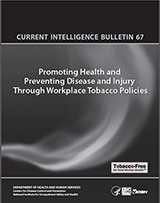Tobacco Smoking
Smoking by Industry, Occupation, & Gender

Cigarette smoking is the leading cause of illness and death in the U.S.1-4 In a study of U.S. adults, results showed 19.6% of workers smoked overall. Current cigarette smoking was highest among the following groups:
- Workers with less than a high school education (28.4%)
- Workers with no health insurance (28.6%)
- Workers living below the federal poverty level (27.7%)
- Workers aged 18–24 years (23.8%)
Cigarette smoking by industry ranged from 9.7% in education services to 30.0% in mining. For occupations, smoking ranged from 8.7% in education, training, and library to 31.4% in construction and extraction.5
Of an estimated 19 million workers in healthcare and social assistance, 16% reported cigarette smoking6, while 25.9% of an estimated 9.3 million workers reported smoking in the accommodation and food services sector7.
Gender differences for smoking by occupation were examined using 2004-2011 National Health Interview Survey data for working adults 18 years or older. The data showed an estimated 22.8% men and 18.3% women workers were current smokers8. Of these workers, 38.9% of women worked as supervisors, and in construction and extraction occupations, while 40.5% of the men worked in extraction occupations. Although, in the healthcare and social assistance sector, more women reported smoking (16.9%) than men (12.6%)6.
Workplace Smoke-Free Policies

Legislation that requires non-hospitality workplaces, restaurants, and bars to be completely smoke-free has been adopted by 27 states and the District of Columbia. These statewide comprehensive smoke-free laws, in addition to local comprehensive smoke-free laws, protect 58.7% of the US population.9 In 1997, smoking was prohibited in all federal government buildings and in aircrafts by Executive Order 13058 “Protecting Federal Employees and the Public from Exposure to Tobacco Smoke in the Federal Workplace.” In 2008, the General Services Administration (GSA) issued the Federal Management Regulation Amendment 2008- 08 banning smoking in courtyards and within 25 feet of doorways on GSA-controlled properties.
The Occupational Safety and Health Administration (OSHA) regulates workplace exposures through 29 CFR 1910.1000 Air contaminants, which does not allow exposures from chemical compounds found in tobacco smoke to exceed certain levels. The Mine Safety and Health Administration (MSHA) adopted policy 30 CFR 75.1702, which states that persons shall not smoke, carry smoking materials, matches, or lighters underground, or smoke in areas that could cause fire or an explosion. The rule also states that the operator shall establish a program to insure this policy is followed.
Employers can implement company specific smoke-free policies in the absence of, or in addition to legislation. Even with smoke-free laws and policies, one in ten nonsmoking U.S. workers continue to report regular exposure to secondhand smoke while at work.10 Workplace secondhand smoke exposure is more common among men than women, it decreases with age and educational achievement, and is most widespread among blue-collar workers and in industries such as mining and construction.10,11,12
Exposures are associated with chronic diseases such as lung cancer, coronary heart disease, and stroke. Secondhand smoke can also cause adverse reproductive effects, including low birth weight, when mothers are exposed during pregnancy.13
NIOSH Recommendations
Worker health and well-being is an important part of establishing a healthy and safe workforce. Addressing the risks of smoking and tobacco use in the workplace and providing tobacco cessation programs for employees is vital to improve overall health of individuals. A recent NIOSH report, Current Intelligence Bulletin 67: Promoting Health and Preventing Disease and Injury Through Workplace Tobacco Policies, is aimed at preventing occupational illness related to tobacco use and secondhand smoke, while also improving the general health and well-being of workers. In the report, NIOSH recommends that all workplaces become tobacco-free and that employers make tobacco cessation programs available to workers. These recommendations are aimed at protecting workers from the occupational hazards of tobacco and the effects of secondhand exposure to tobacco smoke, and also addresses the use of Electronic Nicotine Delivery Systems (ENDS) or e-cigarettes and emissions from e-cigarettes. NIOSH Director, John Howard, M.D. stated “This Current Intelligence Bulletin marks a half century since the first Surgeon General’s Report on the health consequences of smoking. While cigarette smoking in the U.S. has declined more than 50% among all U.S. adults since then, about 20% of all U.S. workers still smoke and far too many nonsmoking workers are still exposed to secondhand smoke at work.” Howard went on to say “These new recommendations are an important step in reducing the number workers who still face the risks associated with tobacco while on the job.”
In the Current Intelligence Bulletin, NIOSH recommends that employers take the following actions related to employee tobacco use:

-
- Establish and maintain smoke-free workplaces that protect those in workplaces from involuntary, secondhand exposures to tobacco smoke and air borne emissions from e-cigarettes and other electronic nicotine delivery systems. Smoke-free workplaces should be established in concert with tobacco cessation support programs. Smoke-free zones should include:
- all indoor areas without exceptions (i.e., no indoor smoking areas of any kind, even if separately enclosed and/or ventilated)
- all areas immediately outside building entrances and air intakes
- all work vehicles
- Establish and maintain smoke-free workplaces that protect those in workplaces from involuntary, secondhand exposures to tobacco smoke and air borne emissions from e-cigarettes and other electronic nicotine delivery systems. Smoke-free workplaces should be established in concert with tobacco cessation support programs. Smoke-free zones should include:
Additionally, all ashtrays should be removed from theses areas.
-
-
- Given available data on the safety of exposure to e-cigarette emissions, these products should be included in indoor smoking policies.
- Establish and maintain entirely tobacco-free workplaces, allowing no use of any tobacco products across the entire workplace campus.
- Comply with current OSHA and MSHA regulations that prohibit or limit smoking, smoking materials, and/or use of other tobacco products in work areas characterized by the presence of explosive or highly flammable materials or potential exposure to toxic materials.
- Provide information on tobacco-related health risks and on benefits of quitting to all employees and other workers at the worksite (e.g., contractors and volunteers).
- Provide information on employer-provided and publicly available tobacco cessation services to all employees and other workers at the worksite (e.g., contractors and volunteers).
- Offer and promote comprehensive tobacco cessation support to all tobacco-using workers and, where feasible, to their dependents. Provide employer-sponsored cessation programs at no cost or subsidize cessation programs for lower-wage workers to enhance the likelihood of their participation.
- Develop, implement, and modify tobacco-related policies, interventions, and controls in a stepwise and participatory manner. Get input from employees, labor representatives, line management, occupational safety/health and wellness staff, and human resources professionals.
- Make sure that any differential employment benefits policies that are based on tobacco use or participation in tobacco cessation programs are designed with a primary intent to improve worker health and comply with all applicable federal, state, and local laws and regulations.
- Ensure that all workers (smokers and nonsmokers) are aware of the occupational safety and health risks associated with their work, including those that can be made worse by personal tobacco use, and how to limit those risks.
-
For further recommendations and guidance on tobacco use in the workplace, click on the Current Intelligence Bulletin.
Intervention and Cessation Programs
The following resources provide information on intervention and cessation programs and guidance for employers and employees.

The Centers for Disease Control and Prevention (CDC)
-
Workplace Health Promotion
Workplace programs and policies to help reduce health risks and improve the quality of life for workers. -
Smoking & Tobacco Use
Guidance for tobacco users that includes information on nicotine dependence, the health benefits of quitting, and ways to quit. -
Quit Smoking
CDC’s website provides smoking cessation information and resources for state tobacco control programs and public health professionals.
U.S. Department of Health and Human Services
-
Smokefree.gov
Guidance provided by the National Institutes of Health – National Cancer Institute for smoke-free support and information.
The American Lung Association
-
Stop Smoking
The American Lung Association provides extensive information on smoking facts, how to quit, and freedom from smoking.
References
CDC. The health consequences of smoking—50 years of progress: a report of the surgeon general, 2014. Atlanta GA: USDHHS, CDC, National Center for Chronic Disease Prevention and Health Promotion, Office on Smoking and Health. www.surgeongeneral.gov/library/reports/50-years-of-progress/exec-summary.pdf
CDC. Current cigarette smoking among adults—U.S., 2011. MMWR Morb Mortal Wkly Rep 2012;61(44):889–94.
CDC. Smoking-attributable mortality, years of potential life lost, and productivity losses—U.S., 2000–2004. MMWR Morb Mortal Wkly Rep 2008; 57 (45):1226–8.
USDHHS. Health consequences of smoking: a report of the Surgeon General. cdc.gov/tobacco/data_statistics/sgr/2004/.
Syamlal G, Mazurek JM, Malarcher AM [2011]. Current cigarette smoking prevalence among working adults – United States, 2004-2010. Morbidity and Mortality Weekly Report (MMWR) 60(38); 1305-1309
Syamlal G, Mazurek JM, Storey E, Dube SR [2015]. Cigarette smoking prevalence among adults working in the health care and social assistance sector, 2008-2012. J Occup Environ Med Oct; 57(10): 1107-1112.
Syamlal G, Jamal A, Mazurek JM [2015]. Current cigarette smoking among workers in accommodation and food services – United States 2011-2013. Morbidity and Mortality Weekly Report (MMWR) 64(29); 797-801.
Syamlal G, Mazurek JM, Dube SR [2014]. Gender differences in smoking among U.S. working adults. Am J Prev Med. Oct;47(4) 467-475.
American Nonsmokers’ Rights Foundation [2016]. Overview list—how many smokefree laws? Available at: http://www.no-smoke.org/pdf/mediaordlist.pdf. Accessed July 29, 2016.
Calvert GM, Luckhaupt SE, Sussell A, Dahlhamer JM, Ward BW [2013]. The prevalence of selected potential hazardous workplace exposures in the US: findings from the 2010 National Health Interview Survey. Am J Ind Med. 56(6):635-646.
Alker H, Fitzsimmons K. On-the-Job Exposure to Environmental Tobacco Smoke (ETS) in Massachusetts. Boston: Massachusetts Department of Public Health; 2013.
The Health Consequences of Smoking—50 Years of Progress: A Report of the Surgeon General [2014]. Atlanta, GA: US Department of Health and Human Services
Fujishiro K, Stukovsky KD, Roux AD, Landsbergis P, Burchfiel C. Occupational gradients in smoking behavior and exposure to workplace environmental tobacco smoke: the Multi-Ethnic Study of Atherosclerosis. J Occup Environ Med. 2012; 54(2):136—145.
- Page last reviewed: November 16, 2016
- Page last updated: November 17, 2016
- Content source:
- National Institute for Occupational Safety and Health Respiratory Health Division (RHD)


 ShareCompartir
ShareCompartir